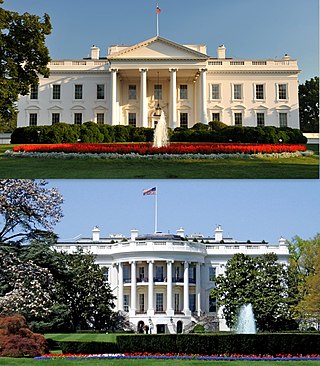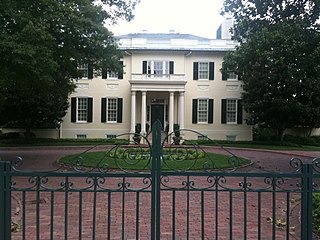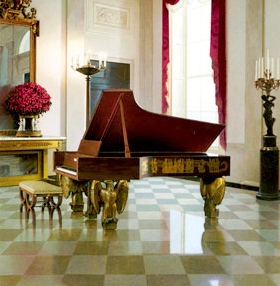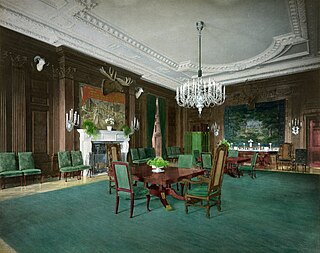Related Research Articles

The White House is the official residence and workplace of the president of the United States. It is located at 1600 Pennsylvania Avenue NW in Washington, D.C., and has been the residence of every U.S. president since John Adams in 1800 when the national capital was moved from Philadelphia. The term "White House" is often used as metonymy for the president and his advisers.

The Texas State Capitol is the capitol and seat of government of the American state of Texas. Located in downtown Austin, Texas, the structure houses the offices and chambers of the Texas Legislature and of the Governor of Texas. Designed in 1881 by architect Elijah E. Myers, it was constructed from 1882 to 1888 under the direction of civil engineer Reuben Lindsay Walker. A $75 million underground extension was completed in 1993. The building was added to the National Register of Historic Places in 1970 and recognized as a National Historic Landmark in 1986.

James Hoban was an Irish-American architect, best known for designing the White House.

The Willard InterContinental Washington, commonly known as the Willard Hotel, is a historic luxury Beaux-Arts hotel located at 1401 Pennsylvania Avenue NW in Downtown Washington, D.C. It is currently a member of Historic Hotels of America, the official program of the National Trust for Historic Preservation. Among its facilities are numerous luxurious guest rooms, several restaurants, the famed Round Robin Bar, the Peacock Alley series of luxury shops, and voluminous function rooms. Owned jointly by Carr Companies and InterContinental Hotels & Resorts, it is two blocks east of the White House, and two blocks west of the Metro Center station of the Washington Metro.

Marion Price Daniel Sr., was an American jurist and politician who served as a Democratic U.S. Senator and the 38th governor of Texas. He was appointed by President Lyndon B. Johnson to be a member of the National Security Council, Director of the Office of Emergency Preparedness, and Assistant to the President for Federal-State Relations. Daniel also served as Associate Justice of the Texas Supreme Court.

Margaret Lea Houston was First Lady of the Republic of Texas during her husband Sam Houston's second term as President of the Republic of Texas. They met following the first of his two non-consecutive terms as the Republic's president, and married when he was a representative in the Congress of the Republic of Texas. She was his third wife, remaining with him until his death.

The Virginia Governor's Mansion, better known as the Executive Mansion, is located in Richmond, Virginia, on Capitol Square and serves as the official residence of the governor of the Commonwealth of Virginia. Designed by Alexander Parris, it is the oldest occupied governor's mansion in the United States. It has served as the home of Virginia governors and their families since 1813. This mansion is both a Virginia and a National Historic Landmark and has had a number of successive renovations and expansions during the 20th century.

The White House Library is a room in the White House, the official home of the president of the United States. The room is approximately 27 by 23 feet and is in the northeast corner of the ground floor. The library is used for teas and meetings hosted by the president and first lady. During the 1950s reconstruction of the White House, old building lumber from the house was salvaged and re-made into wall paneling for this room. Several basement rooms in the White House are paneled with salvaged building materials from the pre-reconstructed White House.

The Diplomatic Reception Room is one of three oval rooms in the Executive Residence of the White House, the official home of the president of the United States. It is located on the ground floor and is used as an entrance from the South Lawn and a reception room for foreign ambassadors to present their credentials, a ceremony formerly conducted in the Blue Room. The room is the point of entry to the White House for a visiting head of state following the State Arrival Ceremony on the South Lawn. The room has four doors, which lead to the Map Room, the Center Hall, the China Room, and a vestibule that leads to the South Lawn.

The Michigan State Capitol is the building that houses the legislative branch of the government of the U.S. state of Michigan. It is in the portion of the state capital of Lansing which lies in Ingham County. The present structure, at the intersection of Capitol and Michigan Avenues, is a National Historic Landmark that houses the chambers and offices of the Michigan Legislature as well as the ceremonial offices of the Governor of Michigan and Lieutenant Governor. Historically, this is the third building to house the Michigan government.

The Entrance Hall is the primary and formal entrance to the White House, the official residence of the president of the United States. The room is rectilinear in shape and measures approximately 31 by 44 feet. Located on the State Floor, the room is entered from outdoors through the North Portico, which faces the North Lawn and Pennsylvania Avenue. The south side of the room opens to the Cross Hall through a screen of paired Roman Doric columns. The east wall opens to the Grand Staircase.

The Grand Staircase is the chief stairway connecting the State Floor and the Second Floor of the White House, the official home of the president of the United States. The stairway is primarily used for a ceremony called the Presidential Entrance March. The present Grand Staircase, the fourth staircase occupying the same general space, was completed in 1952 as a part of the Truman White House reconstruction. The Grand Staircase is entered on the State Floor from the Entrance Hall.

The North Lawn at the White House in Washington, D.C., is bordered on the north by Pennsylvania Avenue with a wide view of the mansion, and is screened by dense plantings on the east from East Executive Drive and the Treasury Building, and on the west from West Executive Drive and the Old Executive Office Building. Because it is bordered by Pennsylvania Avenue, the White House's official street address, the North Lawn is sometimes described as the front lawn.

The West Sitting Hall is located on the second floor of the White House, home of the president of the United States. The room is entered from the second floor Center Hall on the east side of the room. The room features a large lunette window on the west wall looks out upon the West Colonnade, the West Wing, and the Old Executive Office Building. The room is used by first families as a less formal living room than the Yellow Oval Room.
Mary Elizabeth Moody Northen was an American financier and philanthropist from Galveston, Texas. She was the daughter of financial and insurance tycoon William Lewis Moody, Jr. and aunt of businessman Shearn Moody, Jr.

A. H. Davenport and Company was a late 19th-century, early 20th-century American furniture manufacturer, cabinetmaker, and interior decoration firm. Based in Cambridge, Massachusetts, it sold luxury items at its showrooms in Boston and New York City, and produced furniture and interiors for many notable buildings, including The White House. The word "davenport," meaning a boxy sofa or sleeper-sofa, comes from the company.
The Civil War Trust's Civil War Discovery Trail is a heritage tourism program that links more than 600 U.S. Civil War sites in more than 30 states. The program is one of the White House Millennium Council's sixteen flagship National Millennium Trails. Sites on the trail include battlefields, museums, historic sites, forts and cemeteries.

Sam Houston was a slaveholder who had a complicated history with the institution of slavery. He was the president of the independent Republic of Texas, which was founded as a slave-holding nation, and governor of Texas after its 1845 annexation to the union as a slave-holding state. He voted various times against the extension of slavery into the Western United States and he did not swear an oath to the Confederate States of America, which marked the end of his political career.
Sam Houston Jr. (1843–1894) was the oldest of eight children born to Sam Houston and Margaret Lea Houston, and was the only Houston child born in the Republic of Texas, before its December 29, 1845 annexation to the United States. He was home-schooled by his mother, and later attended both Bastrop Military Institute and Baylor University. After Texas seceded from the Union in 1861, he enlisted in the Confederate States Army 2nd Texas Infantry Regiment, Company C Bayland Guards. Wounded at the April 1862 Battle of Shiloh, he served time as a prisoner of war at Camp Douglas in Illinois. Following his release, he received a medical discharge from the Confederate States Army. He attended the Philadelphia University of Medicine and Surgery. Upon graduation, he returned to a private life, and it is unknown if he ever practiced medicine. At some point, he became a writer. Houston married Lucy Anderson in 1875. Their daughter Margaret Bell Houston (1877–1966) was also a writer, as well as a suffragist who became the first president of the Dallas Equal Suffrage Association. Upon his death, Sam Jr. was buried on private property near his mother.
References
- ↑ Anderson, Luke (December 5, 2019). "Local Historian William Seale Dies at 80". Alexandria Times. Retrieved 28 May 2022.
- ↑ According to Seale himself in this 2008 C-SPAN interview at about the 19:45 mark, his father was an "independent oil operator" who "accumulated leases and did drilling."
- ↑ Anderson, Luke (December 5, 2019). "Local Historian William Seale Dies at 80". Alexandria Times. Retrieved 28 May 2022.
- ↑ "William Seale - In Memoriam 1939–2019". WHHA (en-US).
- ↑ http://www.movingmonument.org/seale.html A Moving Monument
- ↑ http://www.senate.michigan.gov/Virtualtour/from%20chamber%20to%20chicken%20coop.htm Original Senate carpet scrap found in chicken coop
- ↑ http://www.tenchimneys.org/guest-book/ Ten Chimneys Who's Who
- ↑ Quigley, Kathleen (1990-03-18). "Splendor Restored At Eastman House". The New York Times. ISSN 0362-4331 . Retrieved 2023-03-24.
- ↑ "Community Deaths: William Seale". The Washington Post. January 18, 2020. Retrieved 28 May 2022.
- ↑ "William Seale - In Memoriam 1939–2019". White House Historical Association.